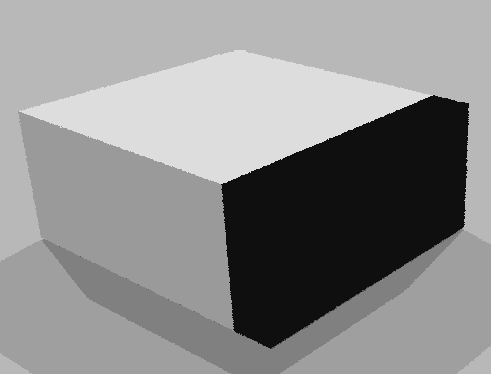FN approach
The aperture used in the FN approach is a collection of polygons that envelopes the façade from all sides. Hemispherical sampling basis is individually assigned for each polygon based on its surface-normal. Figure 66 shows the aperture and Figure 67 describes the location of the surfaces that constitute the aperture. Aside from the individual assignment of hemispherical sampling basis for each polygon, the setup for FN approach differs from FH in one other aspect. As shown in Figure 68, the polygons in the vertical plane are positioned according to the location of the non-coplanar shading device. This is recommended for calculating the flux-transfer above and below the shading device through separate matrices.

Figure 66. The aperture used for the FN approach. The image above appears identical to the image in Figure 64 as in both cases the façade is completely enveloped by the F-aperture. However, as explained earlier through Figure 60, the FN approach usually involves a greater number of polygons and the assignment of individual hemispherical sampling basis per surface. The polygons constituting the F-aperture in the above figure are shown separately in Figure 67.
Figure 67. The seven polygons defined in files fports/FNa.rad, fports/FNb.rad …. fports/FNg.rad together constitute the F aperture for creating the F Matrix. The hemispherical sampling basis is individually assigned for each polygon and is mentioned under the ‘Sampling Comment’ heading. The apertures fports/FNa.rad, fports/FNd.rad and fports/FNf.rad are positioned above the grates. The directional normal for the polygon defined in fports/FNg.rad is parallel to +Z so a hemisphere-up value other than +Z (i.e. +Y) was assigned for it.
Figure 68. Location of the surfaces defined in fports/FNa.rad (left image) and fports/FNb.rad (right image) with respect to the grates.
The assignment of hemispherical sampling basis for rfluxmtx follows the same logic as explained in the earlier sections. As shown in Figure 69 and Figure 70, full Klems-basis (h=kf) is assigned to each of the polygons and the hemisphere-up direction is chosen to be any direction that is not parallel to the directional normal of the polygon.
Figure 69. The assignment of “hemisphere-up” value and Klems-basis for the polygon saved in fports/FNa.rad from Figure 68 . The rfluxmtx comment for fports/FNb.rad, fports/FNc.rad, fports/FNd.rad, fports/FNe.rad and fports/FNf.rad can be the same as all of them will be assigned full klems-basis (h=kf) and a hemisphere-up direction of +Z.
Figure 70. The assignment of “hemisphere-up” value and Klems-basis for the polygon saved in fports/FNg.rad from Figure 68. Out of all the polygons constituting the F-aperture, this is the only whose surface-normal is parallel to the +Z direction. So, the hemisphere-up direction for this surface is assigned as a direction not parallel to the Z direction (u=+Y).
The number of F matrices for the FN approach is equal to the number of F apertures multiplied by the number of T matrix apertures. The number of D matrices will be equal to the number of F matrices. So, as per the arrangement shown in Figure 67, seven F and D matrices will be required in the current example.
The F matrices can be created in a single step by concatenating the files fports/FNa.rad, fports/FNb.rad … fports/FNg.rad to a single file (fports/FN.rad) and then using that file as the ‘sender’ in rfluxmtx.
rfluxmtx -v -ff -ab 4 -ad 10000 -lw 1e-5 -c 5000 -n 8 -o matrices/fmtx/%s.fmx objects/GlazingVmtx.rad fports/FN.rad -i roomFmtx.oct
The output format specified through -o matrices/fmtx/%s.fmx will result in the creation of seven F matrices, namely matrices/fmtx/FNa.fmx, matrices/fmtx/FNb.fmx .. matrices/fmtx/FNg.fmx.
The D matrices required for the FN approach have to be created individually for each polygon of the F-aperture. For the polygon saved in the file fports/FNa.rad:
rfluxmtx -v -ff -ad 10000 -ab 4 -lw 1e-5 -c 5000 -n 8 fports/FNa.rad skyDomes/skyglow.rad -i roomFmtx.oct > matrices/dmtx/DFNa.dmx
The resultant Daylight matrix can be created by multiplying the F-matrix and the daylight matrix:
dctimestep -of matrices/fmtx/FNa.fmx matrices/dmtx/DFNa.dmx > matrices/dmtx/DFNa.dfmx
Similarly, for the polygon saved in fports/FNb.rad …
rfluxmtx -v -ff -ad 10000 -ab 4 -lw 1e-5 -c 5000 -n 8 fports/FNb.rad skyDomes/skyglow.rad -i roomFmtx.oct > matrices/dmtx/DFNb.dmx
dctimestep -of matrices/fmtx/FNb.fmx matrices/dmtx/DFNb.dmx > matrices/dmtx/DFNb.dfmx
… and so on for polygons in fports/FNc.rad … fports/FNg.rad.
The resultant matrices generated above can be combined into a single matrix by adding them together using rmtxop as:
rmtxop matrices/dmtx/DFNa.dfmx + matrices/dmtx/DFNb.dfmx + matrices/dmtx/DFNc.dfmx + matrices/dmtx/DFNd.dfmx + matrices/dmtx/DFNe.dfmx + matrices/dmtx/DFNf.dfmx + matrices/dmtx/DFNg.dfmx > matrices/dmtx/DFN.dfmx